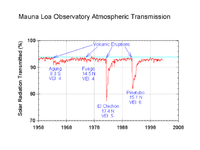
Photo from wikipedia
Ostwald ripening is a diffusional mass transfer process that occurs in polydisperse emulsions, often with the result of threatening the emulsion stability. In this work, we design a simulation protocol… Click to show full abstract
Ostwald ripening is a diffusional mass transfer process that occurs in polydisperse emulsions, often with the result of threatening the emulsion stability. In this work, we design a simulation protocol that is capable of quantifying the process of Ostwald ripening at the molecular level. To achieve experimentally relevant time scales, the Dissipative Particle Dynamics (DPD) simulation protocol is implemented. The simulation parameters are tuned to represent two benzene droplets dispersed in water. The coalescence between the two droplets is prevented via the introduction of membranes, which allow diffusion of benzene from one droplet to the other. The simulation results are quantified in terms of the changes of the droplets volume as a function of time. The results are in qualitative agreement with experiments. The agreement with the Lifshitz-Slyozov-Wagner theory becomes quantitative when the simulated solubility and diffusion coefficient of benzene in water are considered. The effect of two different surfactants was also investigated. In agreement with both experimental observations and theory, the addition of surfactants at moderate concentrations decreased the Ostwald ripening rate because of the reduction in the interfacial tension between benzene and water; as the surfactant film becomes dense, other phenomena are likely to further delay Ostwald ripening. In fact, the results suggest that the surfactant that yields higher density at the benzene-water interface delayed more effectively Ostwald ripening. The formation of micelles can also affect the ripening rate, in qualitative agreement with experiments, although our simulations are not conclusive on such effects. Our simulations show that the coarse-grained DPD formalism is able to capture the molecular phenomena related to Ostwald ripening, and reveal molecular-level features that could help to understand experimental observations. The results could be useful for predicting, and eventually controlling the long-term stability of emulsions.
Journal Title: Journal of chemical theory and computation
Year Published: 2019
Link to full text (if available)
Share on Social Media: Sign Up to like & get
recommendations!